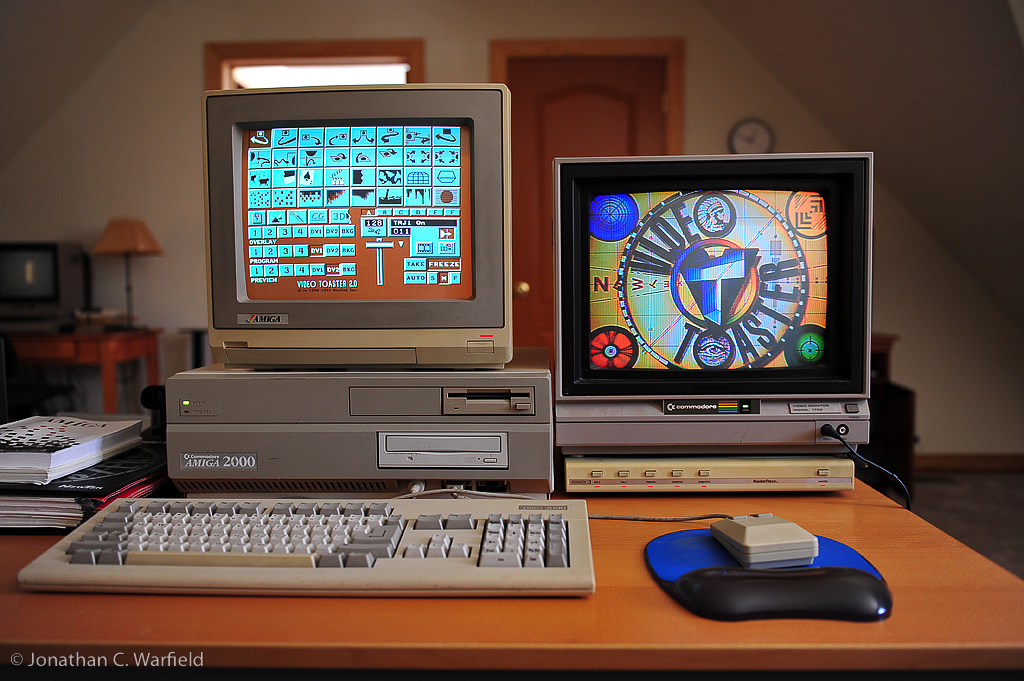
Commodore Amiga 2000 Video Toaster (1990)
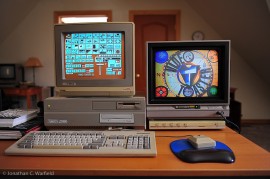
In 1990, a small startup called NewTek set the video production world on its ear when it unveiled the revolutionary Video Toaster and ushered in the era of desktop video production.
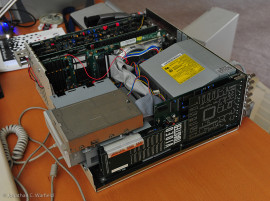
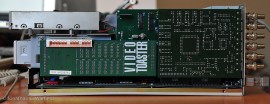
The Video Toaster was a combined hardware/software solution that turned a desktop computer into a Hollywood digital special effects studio. The hardware consisted of a special expansion board inserted into an Amiga 2000 computer, and once installed and properly configured, the Video Toaster could perform a plethora of video effects. First, it was a sophisticated “switcher”, enabling the operator to switch between various video input sources and apply scores of digitized transition effects from one scene to the next. Secondly, it was a sophisticated 3D rendering and animation studio that enabled the user to create complex 3D CG renderings that could then be animated. Chances are you’ve seen a Video Toasters capability in this area if you watched TV shows such as Babylon 5 or Sequest DSV. Both of these TV shows used the video toaster to render spacecraft, underwater craft and the virtual worlds they travelled in. Keep in mind that this was 1990 and this could be done on a desktop. Prior to the Video Toaster, you could easily spend 100 – 300K USD for professional equipment with similar capability. Lastly there were Paint and CG titling programs.
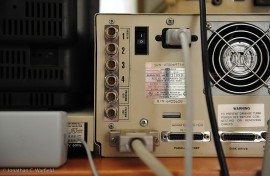

From the back, the Video Toaster card provided four video inputs and two specialized outputs for performing work. From the front, the Video Toaster made use of 2-3 monitors to allow the user to see the control interface on one monitor, and the applied effects and final output on either one or two additional monitors. The Amiga computer was ideally suited to the toaster because of its system clock ran at 7.16MHz, which was precisely double that of the NTSC color carrier frequency, 3.579MHz, allowing for simple syncronization of the video signal. Imagine producing Hollywood digital effects today on a computer running at 7.6MHz!
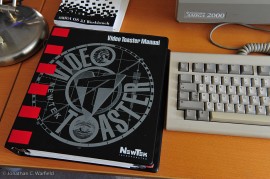
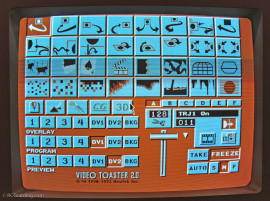
In the days before online help, you would normally get a giant manual to go with your complicated computer products. The Video Toaster was no exception, providing a nice three-ring binder for all of the documentation. On the right is the interface as seen on the computer monitor. The four rows of buttons are one of six screens of buttons for various switching effects. The graphic on each button gives the user an idea of what the transition effect looks like. On the lower left are buttons for the Paint, Graphics and 3D programs and the various input selectors. On the lower right, more configuration buttons and the effects slider.
One of the limitations of the early Video Toasters was it’s inability to do non-linear editing. Any effects applied to recorded video had to be done in real time, with the footage rolling as effects were applied. This changed, however, when Newtek released the Video Toaster Flyer. The Flyer was an additional expansion board that allowed video to be captured and stored on hard drive for later editing. We take this for granted on our PC and Mac’s today, but this was quite an accomplishment back in the early 90’s on machines that were running around 7 to 40MHz. The Flyer board was pretty much a computer in itself, with provisions for mounting 21(!) SCSI hard drives (7 in each SCSI chain on 3 SCSI ports) for capturing and editing audio and video (audio and video were captured on separate drives, probably due to processing and bandwidth limitations in the SCSI bus of the time).
I am in the process of completing my Amiga A2000 Video Toaster outfit and am also building an Amiga A4000T (T for Tower case) Video Toaster/Flyer system. Once operational, I hope to record some of my vintage Tamiya vehicles running around and edit them 1990’s style for that real vintage feel.
Check out these YouTube videos on just what the Video Toaster can do:
This video is from a 1990 broadcast of the Computer Chronicles TV show where the founders and designers of the Video Toaster system demo its capabilities live.
Demo video from NewTek showing just what the Video Toaster can do. I love narrators that talk to themselves.
This is another demo video produced by NewTek.
[wordbay]commodore amiga[/wordbay]
You may also like
3 comments
Leave a Reply
Archives
- December 2025
- November 2025
- October 2025
- September 2025
- August 2025
- July 2025
- June 2025
- May 2025
- April 2025
- March 2025
- February 2025
- January 2025
- December 2024
- November 2024
- October 2024
- September 2024
- August 2024
- June 2024
- May 2024
- March 2024
- January 2024
- November 2023
- October 2023
- September 2023
- August 2023
- September 2013
- August 2013
- March 2013
- September 2012
- June 2012
- December 2011
- August 2011
- July 2011
- May 2011
- March 2011
- January 2011
- December 2010
- November 2010
- September 2010
- August 2010
- July 2010
- June 2010
- April 2010
- March 2010
- February 2010
- January 2010
- December 2009
- November 2009
- October 2009
- September 2009
- August 2009
- July 2009
- June 2009
- May 2009
- April 2009
- March 2009
- February 2009
- January 2009
- December 2008
- November 2008
- October 2008
- September 2008
- August 2008
- July 2008
- June 2008
- May 2008
- April 2008
- March 2008
- February 2008
- January 2008
- December 2007
- November 2007
- October 2007
- September 2007
We had one of these Toaster systems in our high school back in the early 90’s. We used it for our high school news program on closed circuit TV to do effects and titling. We all thought it was amazing, and it was, especially for the time. Way ahead of its time.
The Amiga rocks!!! Way ahead of its time. First multitasking OS ahead of Mac and PC. RIP Commodore.
Amiga definitely rocks. Full multitasking O/S on a 720k disk ! 🙂
I setup an Amiga video system at Kent Fire Brigade for their video studio, we had great fun working on the fire brigade video magazine and video copy for press release…..
Did all the music too a lot of it on the Amiga as well … Ah those days ! 🙂